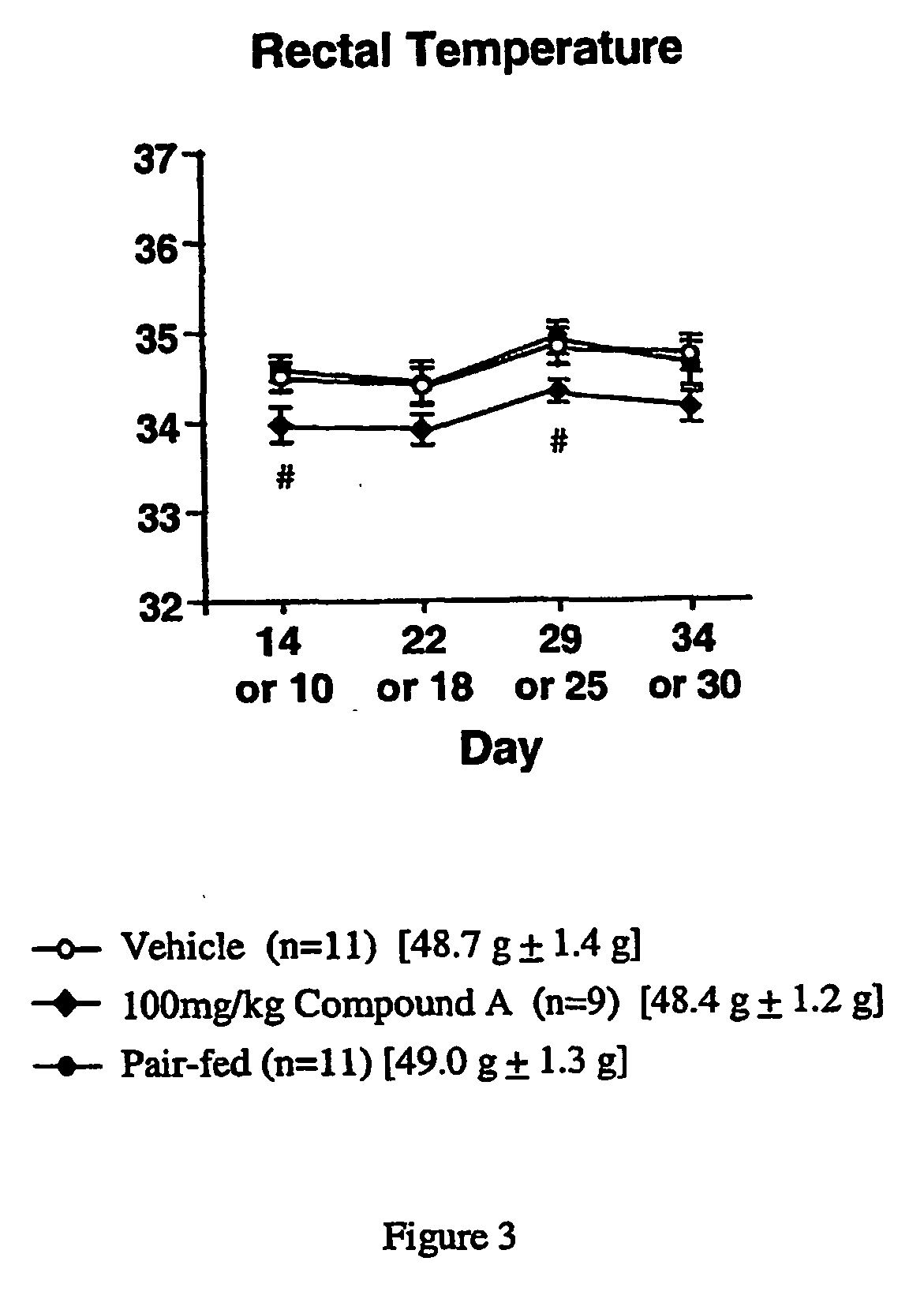Combination therapy for the treatment of obesity
- Summary
- Abstract
- Description
- Claims
- Application Information
AI Technical Summary
Benefits of technology
Problems solved by technology
Method used
Image
Examples
example 1
In Vivo Pair-Feeding Study with a NPY5 Antagonist
Materials and Methods
[0588] Compound A, is an orally active, selective NPY5 antagonist (Kanatani et al., 2000, Biochem. Biophys. Research Comm. 272:169-173). Male C57BL / 6J mice (CLEA Japan Inc., 16 months old at the beginning of the drug administration) were used. Mice were given water and regular pellet chow (CE-2, CLEA Japan Inc.) ad libitum. They were kept in an animal room which was maintained at 23±2° C. temperature, 55±15% relative humidity and on a 12-hr light-dark cycle (7:00-19:00) during a quarantine and acclimatization period of 1 week.
[0589] Before the start of drug administration, mice were fed a MB diet (Oriental BioService Co., Tokyo, Japan) for about 9 to 10 months until the body weight gain reached plateau. After the body weight gain reached a plateau, the diet was change to a powder MHF diet. The powder MEW diet was given by powder feeder (small dishes). Diet and dishes were changed everyday, and daily food inta...
example 2
In Vivo Study of a Combination of a NPY5 Antagonist and Food Restriction
Materials and Methods
[0592] Male C57BL / 6J mice (CLEA Japan Inc., 14 months old at the beginning of the drug administration) were used. Mice were given water and a regular pellet chow (CE-2, CLEA Japan Inc.) ad libitum. They were kept in an animal room which was maintained at 23±2° C. temperature, 55±15% relative humidity and on a 12-hr light-dark cycle (7:00-19:00) during a quarantine and acclimatization period of 1 week. Before the start of drug administration, mice were fed a MHF diet (Oriental BioService Co., Tokyo, Japan) for about 9 to 10 months until the body weight gain reached a plateau. After the body weight gain reached a plateau, the diet was changed to a powder MHF diet. The powder MHF diet was given by powder feeder (small dishes). Diet and dishes were changed everyday, and the daily food intake was measured. During this period, animals were orally administered vehicle (0.5% methylcellulose in d...
example 3
In Vivo Study for Combination Therapy with a NPY5 Antagonist and a Second Anti-Obesity Agent
[0594] DIO mice are treated simultaneously with an effective dose of a NPY5 antagonist and an effective dose of a second anti-obesity agent.
Materials and Methods
[0595] Male C57BL / 6J mice (CLEA Japan Inc., 12-16 months old at the beginning of the drug administration) are used. Mice are given water and regular pellet chow (CE-2, CLEA Japan Inc.) ad libitum. They are kept in an animal room which is maintained at 23±2° C. temperature, 55±15% relative humidity and on a 12-hr light-dark cycle (7:00-19:00) during a quarantine and acclimatization period of 1 week. Before the start of drug administration, mice are fed a MHF diet (Oriental BioService Co., Tokyo, Japan) for about 9 to 10 months until the body weight gain reaches a plateau. After the body weight gain reaches a plateau, the diet is changed to a powder MHF diet. The powder MHF diet is given by powder feeder (small dishes). Diet and di...
PUM
| Property | Measurement | Unit |
|---|---|---|
| Electrical conductance | aaaaa | aaaaa |
| Volume | aaaaa | aaaaa |
| Fraction | aaaaa | aaaaa |
Abstract
Description
Claims
Application Information
 Login to View More
Login to View More - R&D
- Intellectual Property
- Life Sciences
- Materials
- Tech Scout
- Unparalleled Data Quality
- Higher Quality Content
- 60% Fewer Hallucinations
Browse by: Latest US Patents, China's latest patents, Technical Efficacy Thesaurus, Application Domain, Technology Topic, Popular Technical Reports.
© 2025 PatSnap. All rights reserved.Legal|Privacy policy|Modern Slavery Act Transparency Statement|Sitemap|About US| Contact US: help@patsnap.com



